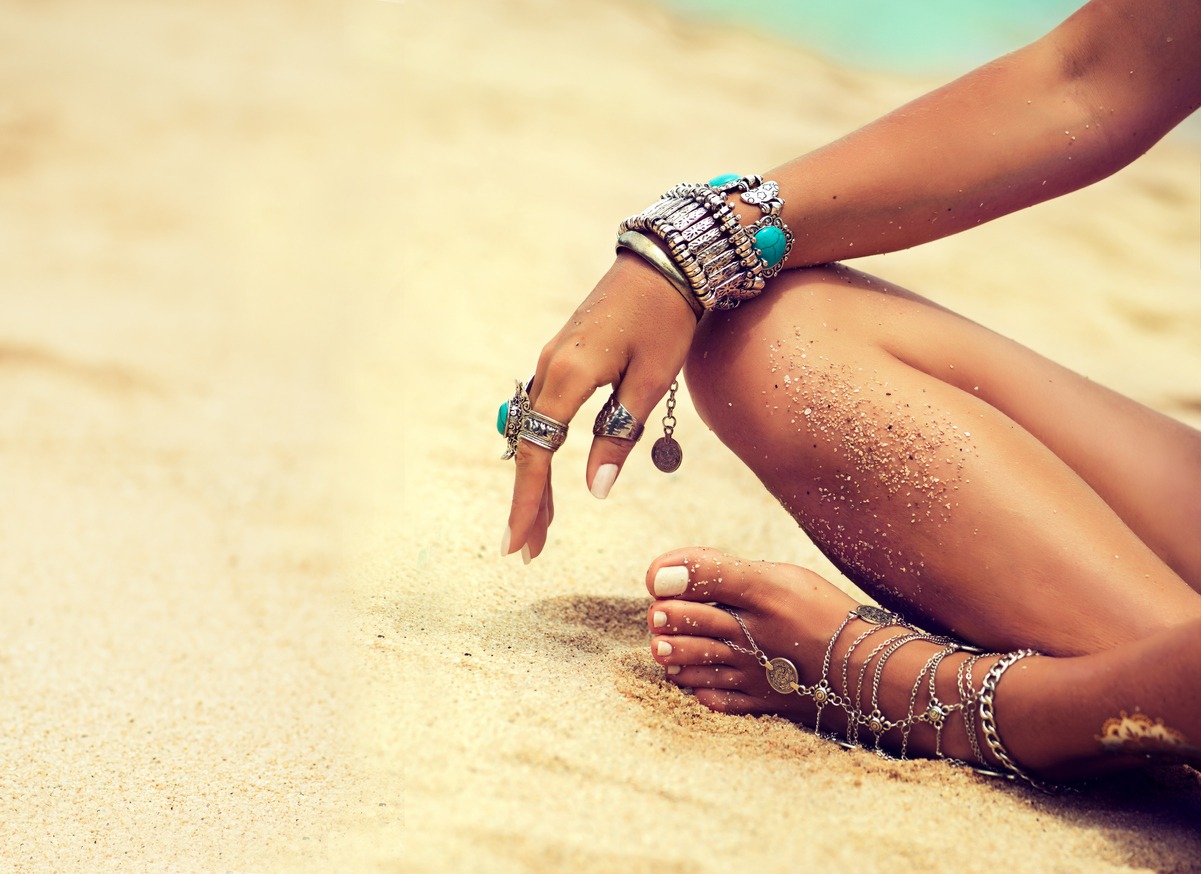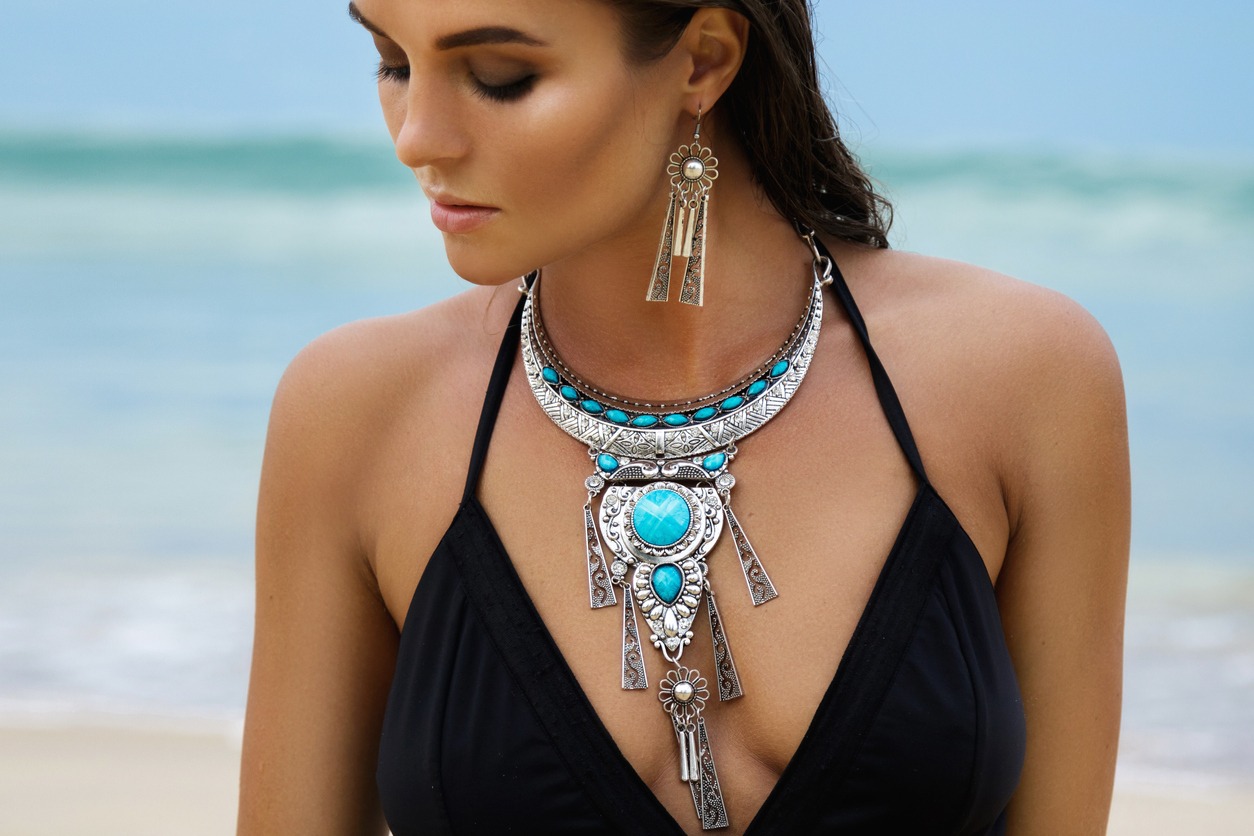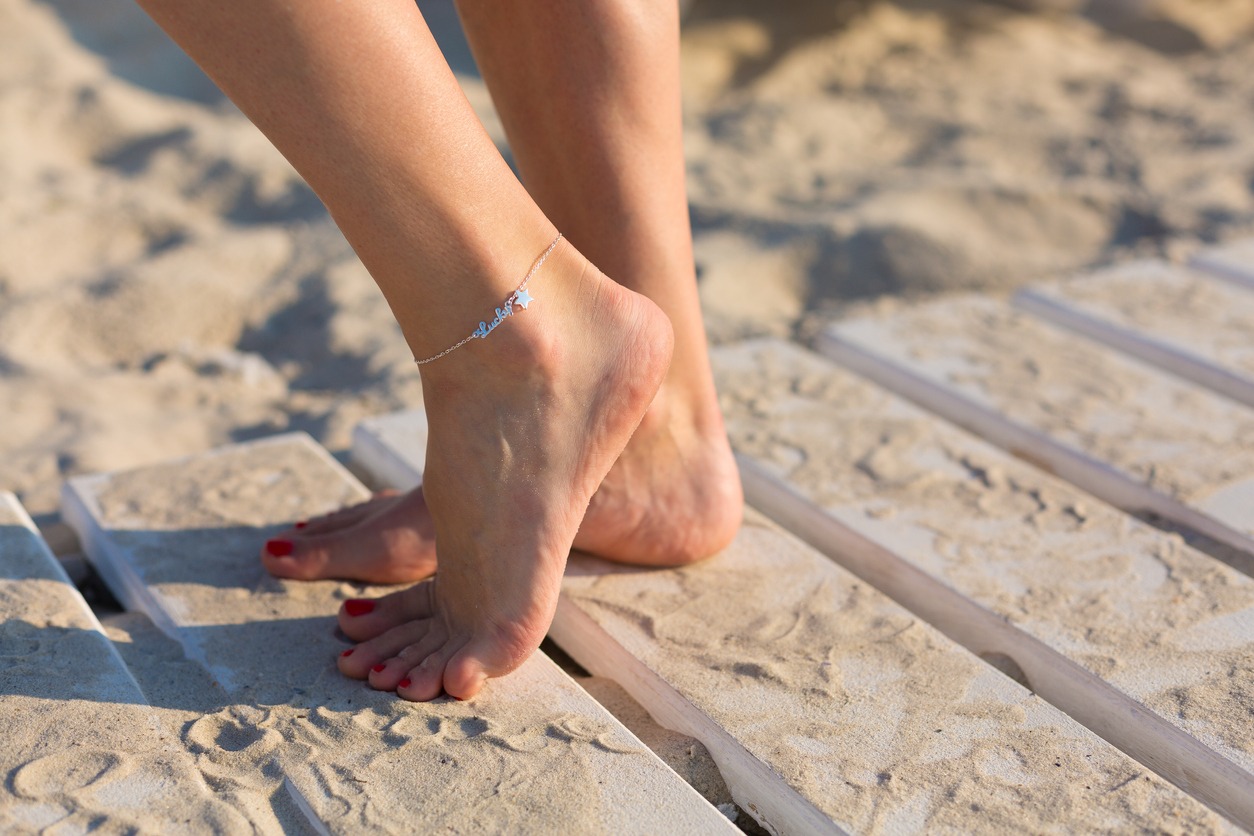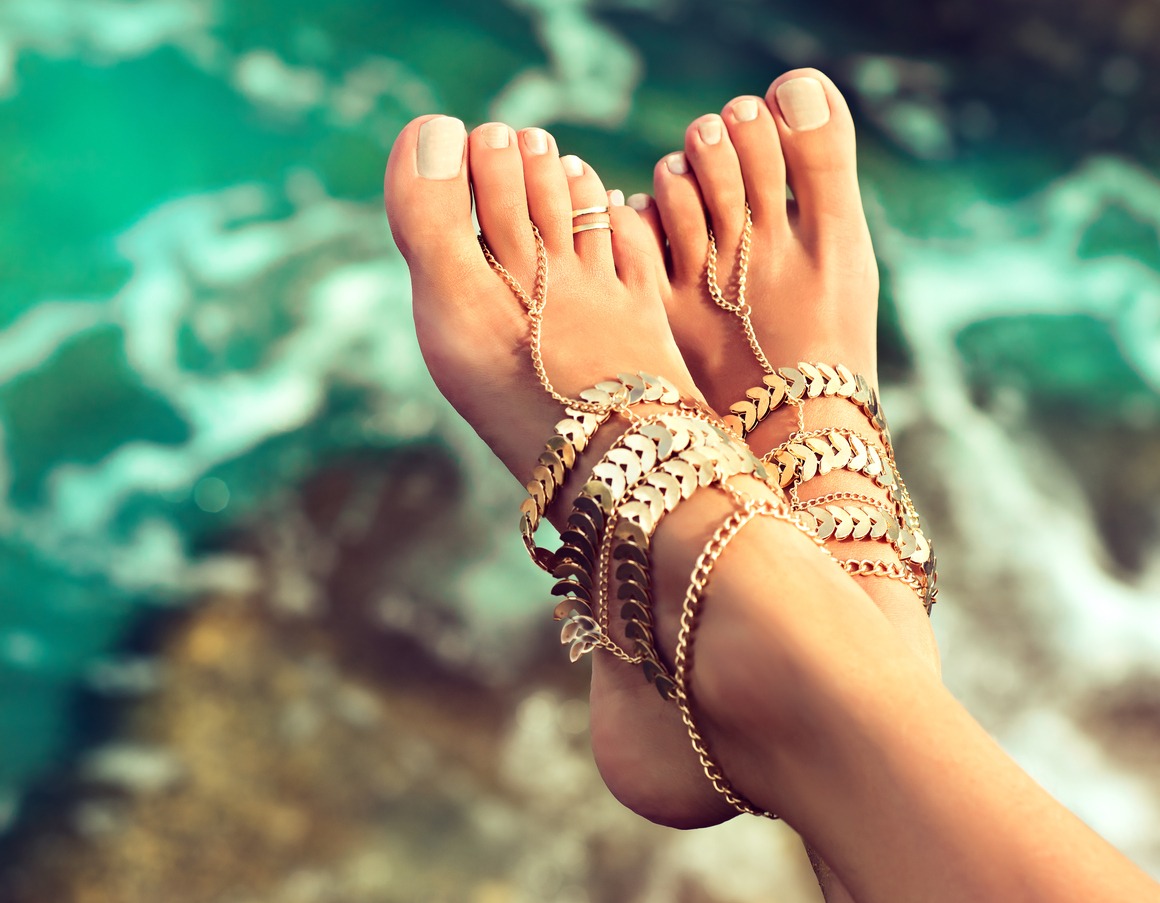Think again if you believe that wearing a pretty bikini, a pair of adorable flip-flops, and a stylish cover-up will be enough to complete your summer outfit of the day. If you didn’t know, the beach is frequently a huge catwalk where women and even men show off their fashion for all to see and admire. It is time for you to get on the fashionista bus and step up your game by accessorizing your bikinis and cover-ups with some fantastic beach jewelry.
The truth is that anyone can choose any bracelet or necklace at random and wear it with a swimsuit, but only a true fashion expert can pull it off. Fortunately, you’ve come to the right place because we’re going to share some tips with you on how to be stylish and Instagram-worthy while wearing jewelry to the beach and pool.
Guide to Wearing Jewelry at the Beach and Pool
It is possible to wear jewelry at the beach and pool, and it can be enjoyable to select the ideal pieces to accessorize your swimwear. But that doesn’t mean accessorizing for a day at work or a shopping trip is as easy as accessorizing for a day at the beach and pool. It’s advisable to follow a few guidelines for your peace of mind as well as the health and longevity of your jewelry. Try to follow these tips if you want to add some sparkle to your beach and pool day.
1. Match your Jewelry with Your Swimsuit
Your beach jewelry should match your swimsuit, which is the first crucial step you should keep in mind. It will look best paired with just a straightforward hook earring if you have a swimsuit that is sporty in style. Wearing a swimsuit with high-cut bottoms will give you a classy vibe, so pair it with a necklace featuring vintage pendants or barrettes. The best jewelry to wear, however, is color-block necklaces and cuff bracelets if you decide to wear a simple, solid-colored swimsuit.
2. Mix and Match Different Jewelry
Remember that choosing the appropriate beach jewelry requires considering other accessories in addition to the style and color of your swimsuit. For instance, you could wear a basic swimsuit, cover it with a kaftan, and accessorize with a pendant necklace and cuff bracelet for a romantic chic look. If you want to channel some Hollywood glamour, don a retro swimsuit, a chic sun hat, and cute accessories like cherry earrings.
3. Be Aware of Hazards
It’s important to be aware of all the potential damage your jewelry may sustain when wearing it on the beach. You’ll be dealing with the following issues, to name a few of the most pressing ones.
- Sand: When it’s between your toes, sand may feel soft, but it contains millions of tiny stones and rough grains that can cause a great deal of harm. If sand gets caught between your skin and the jewelry, it can scratch or otherwise damage it.
- Salt: Salty ocean water contains chemical elements that are more dangerous for your jewelry than water from your tap. Depending on the type of metal used to make the jewelry, saltwater can tarnish or otherwise stain it.
- Water: Water poses a risk not so much because it can harm your jewelry but rather because it makes it simple for you to lose it. The chances of finding a lost piece while swimming in the ocean are extremely slim.
- Sun exposure: No matter where you go, exposure to the sun is frequently unavoidable, but the sun’s rays at the beach are especially potent and can dull metal or dull gems.
- Sunscreen: Jewelry and sunscreen don’t go together well. Unfortunately, it is not possible to forgo sunscreen at the beach. The greasy film that is created when you accidentally rub this cream onto your jewelry while applying it to your skin will quickly tarnish the piece and eat away at the finish.
4. Consider the Loss
Always consider how upset you would be if you lost or damaged a piece of jewelry before deciding whether or not to wear it to the beach. It’s probably best to leave the piece in your room if the response is “very much.” Although it is unlikely that you will lose your jewelry, it is always a possibility that you can easily avoid it by leaving it in your room.
5. Less is More
At the beach, try sticking to smaller pieces. The resultant tan lines will be larger and more noticeable the more substantial the jewelry. Larger jewelry also has a higher chance of entangling you, getting caught in the wind, or getting stuck in your bathing suit.
6. Take it Off Before Swimming
Remember to take off any jewelry you’re wearing before you go swimming if you’re wearing it to lounge on the sand. Keep in mind that anything you wear in the water runs the risk of disappearing. To prevent this, take a moment to take off any jewelry you may be wearing and put it in your beach bag where it will be safe until you return.
7. Bring Some Sandwich Bags
Do you take your jewelry off when you swim? You’ll need a trustworthy method to keep it secure in the interim. Consider putting a few sandwich-sized plastic bags in your beach bag. Whenever you take off a piece of jewelry, put it inside one of these baggies. Your jewelry will be much less likely to fall out of your beach bag and into the sand if you do this. Furthermore, it will aid in shielding priceless items from the sand that will unavoidably make their way into your beach bag.
What Jewelry is Best to Wear at the Beach
How do you decide which piece to wear as jewelry at the beach? How can you tell which ones will withstand beach weather conditions better?
It turns out that there are a few different things to consider that will assist you in figuring out the responses to these questions.
1. Worth
As we previously mentioned, one of the best ways to choose which jewelry to bring to the beach and which to leave at home is to consider how upset you would be if you lost it. Always stick to pieces you aren’t overly attached to as a general rule. It’s best to leave any items that hold a lot of sentimental value as well as any highly valuable items at the hotel. Instead, consider fashion jewelry.
2. Type of Metal
Knowing the different metals your jewelry is made of is a good idea because some metals will withstand the rigors of a beach day better than others. As a result of exposure to the high salt content of the water and air at the beach, pewter, copper, and sterling silver are all susceptible to tarnishing. Gold and platinum are better options because they will more effectively withstand tarnish and staining.
3. Gems
Do you use precious stones in your jewelry? If so, it will lose some of its beach resilience. A harder stone will be less impacted, while a softer stone will be more easily scratched or damaged. Try hard gems like rubies, sapphires, and diamonds, of course. Avoid delicate gemstones like amethyst.
Another choice is to choose plain jewelry and completely omit the gems. Although you still need to worry about the metal itself, one of your concerns is gone because there isn’t a gemstone. As an alternative, you might select jewelry that has faux gems. These are also probably to be harmed, but since they aren’t worth much financially, it doesn’t matter as much.
4. Fit
Keep in mind that it’s simple for jewelry to become loose while you’re swimming in the ocean and slide off your body without you even realizing it. The missing piece might not even be noticed until you return to the hotel. Avoid this issue by wearing jewelry that is too loose and doesn’t fit you well. This isn’t relevant when talking about bracelets or loose necklaces, but it does apply when talking about rings.
5. Tanning
Many people spend a significant portion of their beach day sprawled out on a towel, allowing the sun to warm their skin. If this is your strategy, you might want to avoid wearing bulky necklaces and wrist cuffs. Even though they might look glamorous when you’re wearing a bathing suit, they’ll probably give you some strange-looking tan lines that you might not like.
Tips for Caring for Your Jewelry After the Beach
It’s important to take the right precautions to care for your jewelry after a long day of outdoor recreation. After all, you’ve scrubbed it with sand, immersed it in saltwater, and most likely applied a generous amount of sunscreen. You’ll need to take a little extra care with your jewelry if you want to keep it looking fine and sparkly.
1. The Basic Wipe-Down
You might only need to give your jewelry a quick wipe-down if you get back from the beach and discover that it is almost entirely unharmed. This method is useful if you need to clean your jewelry quickly but don’t have enough time for the complete procedure.
Use a soft, damp cleaning cloth to gently wipe your jewelry’s surfaces to prevent tarnish and wear from developing. Make sure to get into all the nooks and crannies. This makes sure that any salt, sand, or sunscreen that may have adhered to the metal’s surface is removed and won’t keep corroding the jewelry.
2. The Heavier Cleaning
Once you get back from the beach, all jewelry should go through this more thorough cleaning procedure. Certainly, don’t be hesitant to start this cleaning regimen if your jewelry is greasy or sand-covered.
The sooner you wash your jewelry after returning from the beach, the better, as the longer the contaminants are allowed to remain on the metal, the more damage they can do. Try combining water and any soap you happen to have on hand, like body wash or hand soap, for your cleaning solution. Heavy-duty cleaning products must be strictly avoided as they will only cause further damage to the jewelry.
With your cleaning solution wet on a soft cloth, carefully clean the entire item of jewelry. Make sure to carefully maneuver your cloth around each hinge, ledge, and surface. Take a dry cloth and rub the jewelry clean once you are certain that you have thoroughly cleaned the entire item. When the jewelry is dry, leave it out in a secure location to air it out before putting it in your jewelry box. Avoid storing the jewelry when it is still wet because this can cause rust.
3. A Professional Cleaning
While having your jewelry professionally cleaned after every beach trip may seem a bit excessive, it’s impossible to overstate the value of this step. Consider beginning your fall with a trip to a jeweler for expert cleaning after a long summer of beach vacations.
A professional will be able to remove minute sand particles and other contaminants that you won’t be able to reach on your own using highly specialized cleaning agents and tools. This procedure ensures that your jewelry will retain its beauty and sparkle for another year while also removing the last signs of beach wear.
Even if your jewelry appears unharmed following a trip to the beach, it is still wise to spend money on this expert cleaning. The sand or salt may not be visible, but that doesn’t mean they aren’t. It might be concealed in crevices or crusted on the surface in imperceptible particles. Always choose safety over regret. Simply have your jewelry cleaned by a professional at the end of the season rather than taking the chance that it will become rusted, corroded, and discolored.
Conclusion
A touch of shimmer is always welcome during the warm summer months. You should always make an effort to look your absolute best, regardless of whether you are going on a cruise, staying at a resort in the tropics, lounging by the pool, or just relaxing on the beach. This is your guide to wearing jewelry at the beach and pool so that you can achieve that stunning look while you’re on vacation.






